 |
| Thomas' Legion |
| American Civil War HOMEPAGE |
| American Civil War |
| Causes of the Civil War : What Caused the Civil War |
| Organization of Union and Confederate Armies: Infantry, Cavalry, Artillery |
| Civil War Navy: Union Navy and Confederate Navy |
| American Civil War: The Soldier's Life |
| Civil War Turning Points |
| American Civil War: Casualties, Battles and Battlefields |
| Civil War Casualties, Fatalities & Statistics |
| Civil War Generals |
| American Civil War Desertion and Deserters: Union and Confederate |
| Civil War Prisoner of War: Union and Confederate Prison History |
| Civil War Reconstruction Era and Aftermath |
| American Civil War Genealogy and Research |
| Civil War |
| American Civil War Pictures - Photographs |
| African Americans and American Civil War History |
| American Civil War Store |
| American Civil War Polls |
| NORTH CAROLINA HISTORY |
| North Carolina Civil War History |
| North Carolina American Civil War Statistics, Battles, History |
| North Carolina Civil War History and Battles |
| North Carolina Civil War Regiments and Battles |
| North Carolina Coast: American Civil War |
| HISTORY OF WESTERN NORTH CAROLINA |
| Western North Carolina and the American Civil War |
| Western North Carolina: Civil War Troops, Regiments, Units |
| North Carolina: American Civil War Photos |
| Cherokee Chief William Holland Thomas |
| HISTORY OF THE CHEROKEE INDIANS |
| Cherokee Indian Heritage, History, Culture, Customs, Ceremonies, and Religion |
| Cherokee Indians: American Civil War |
| History of the Eastern Band of Cherokee Indian Nation |
| Cherokee War Rituals, Culture, Festivals, Government, and Beliefs |
| Researching your Cherokee Heritage |
| Civil War Diary, Memoirs, Letters, and Newspapers |
|
|
 |
|
Civil War Battle of Stones River, Tennessee
Stones River Battlefield and the American Civil War
Stones River National Battlefield Park Guide
| Battle of Stones River Guide |
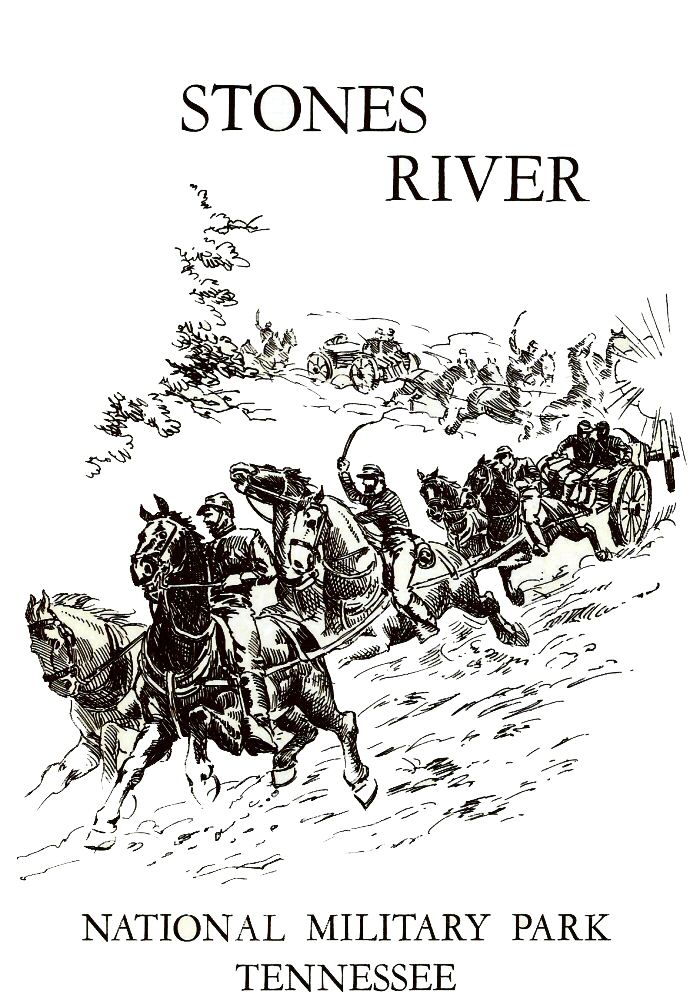
|
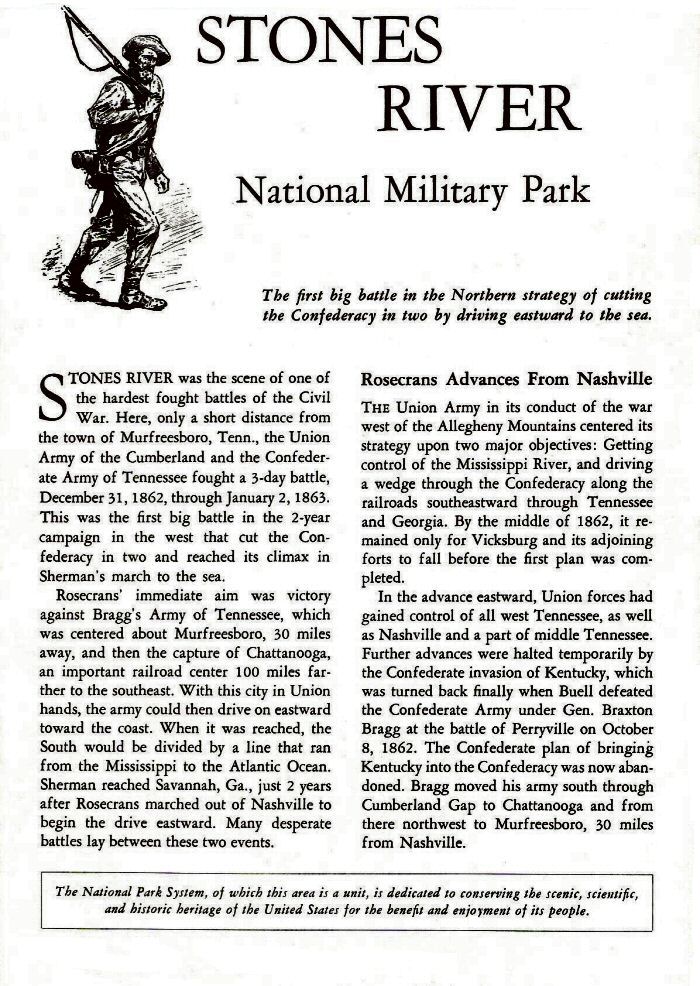
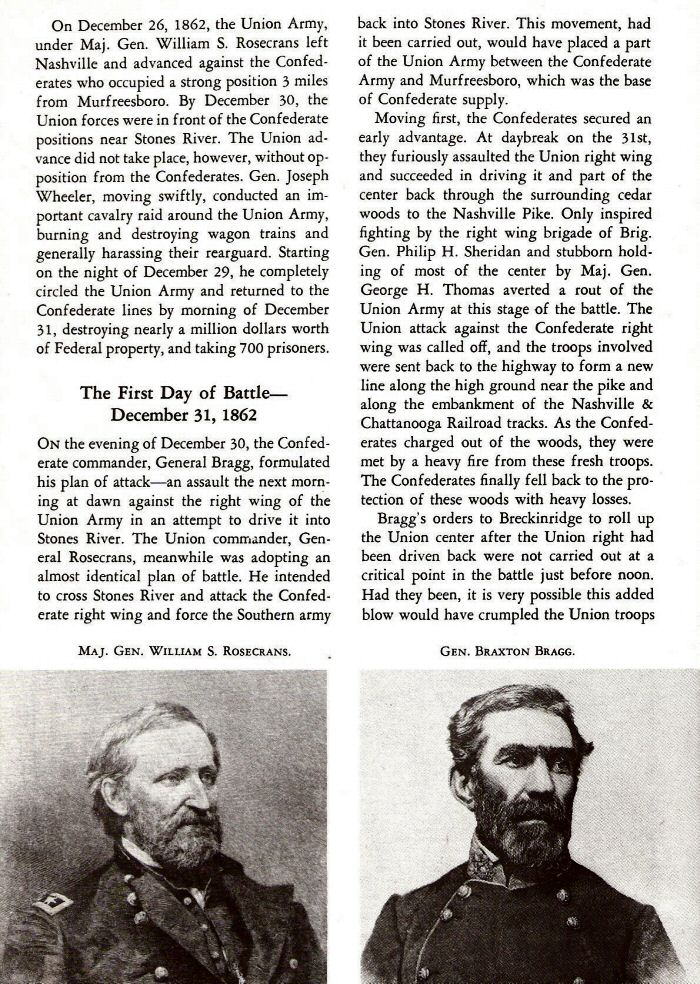
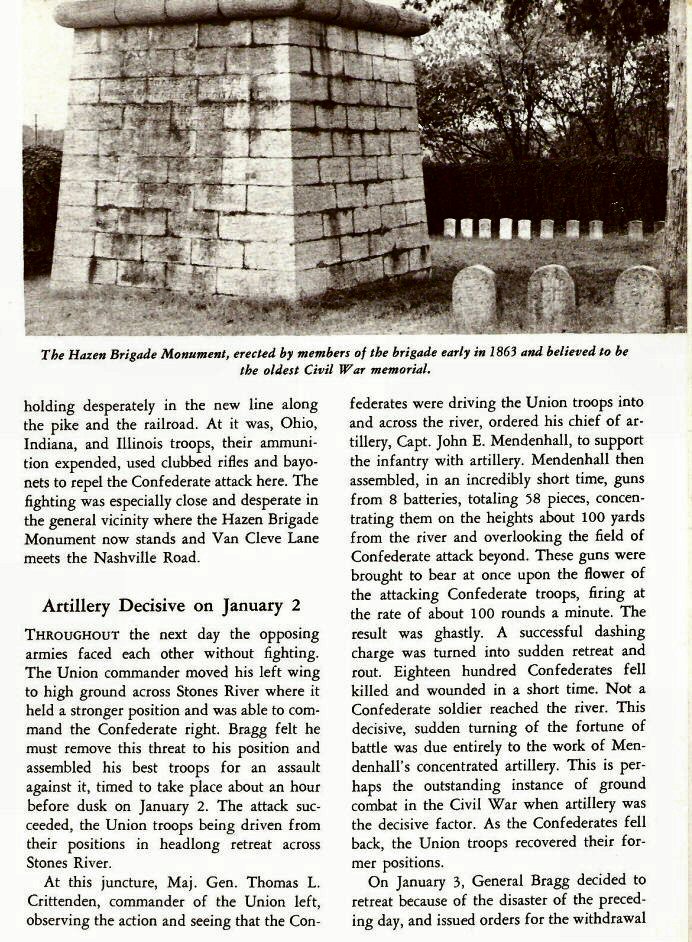
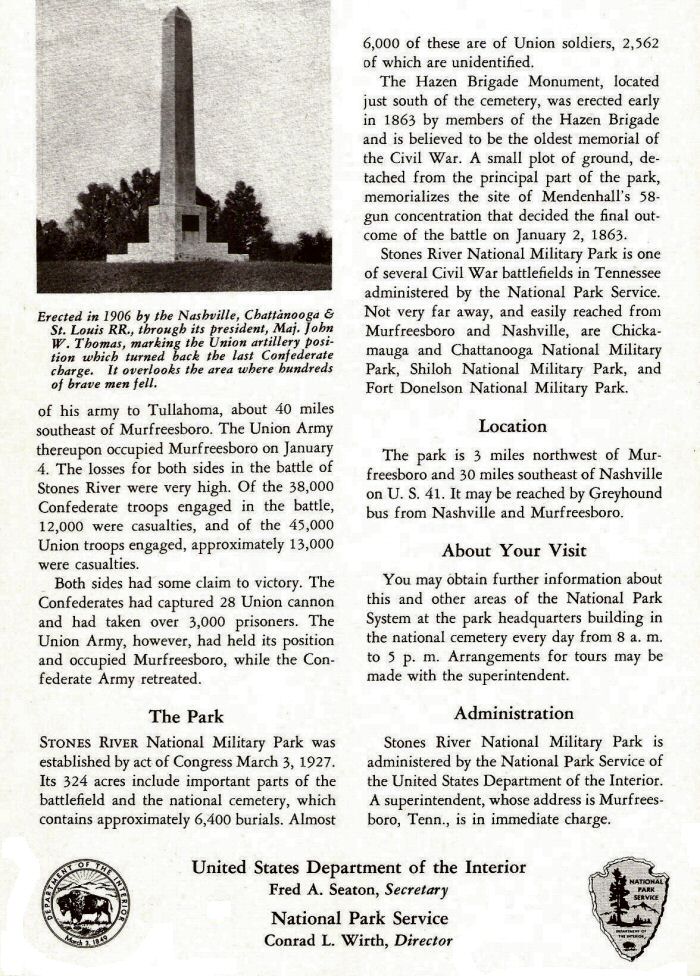
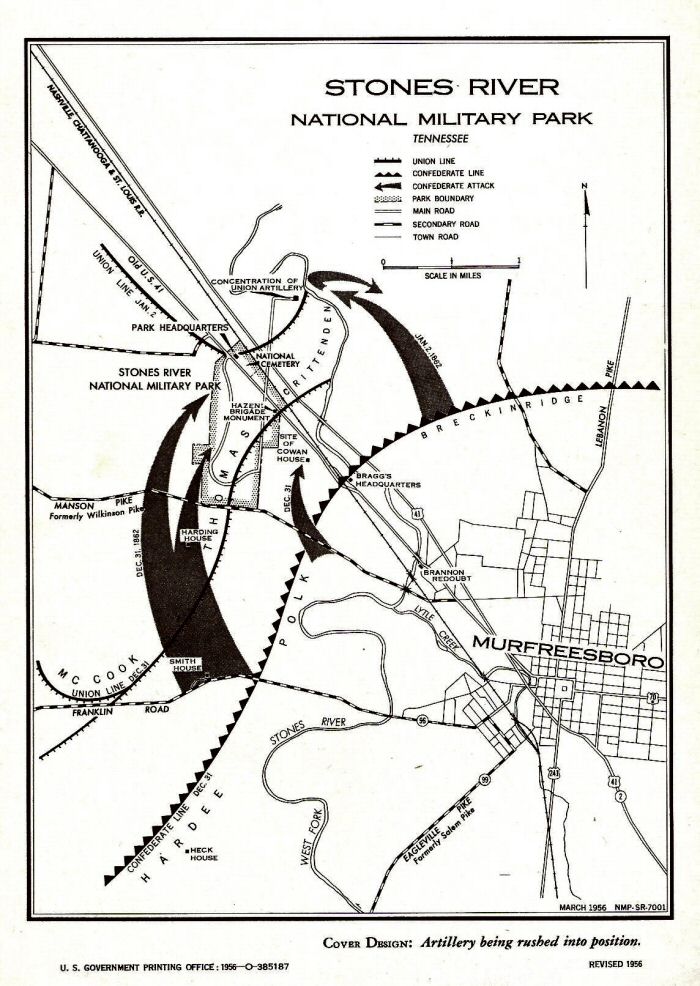
(Related reading below.)
Credit: Stones River National Battlefield Park
Recommended Reading: No Better Place to Die: THE BATTLE OF STONES
RIVER (Civil War Trilogy). Review
from Library Journal: Until now only three book-length studies of the bloody Tennessee
battle near Stone's River existed, all old and none satisfactory by current historical standards. This important book covers
the late 1862 campaign and battle in detail. Though adjudged a tactical draw, Cozzens shows how damaging it was to the South.
Continued below.
Not only did
it effectively lose Tennessee, but it completely rent the upper command structure of the Confederacy's major
western army. Valuable for its attention to the eccentric personalities of army commanders Bragg and Rosecrans, to the overall
campaign, and to tactical fine points, the book is solidly based on extensive and broad research. Essential for period scholars
but quite accessible for general readers.
Advance to:
Editor's Choice: CIVIL
WAR IN WEST SLIP CASES: From Stones River to Chattanooga
[BOX SET], by Peter Cozzens (1528 pages) (University
of Illinois Press). Description:
This trilogy very competently fills in much needed analysis and detail on the critical Civil War battles of Stones River, Chickamauga
and Chattanooga. "Cozzens
comprehensive study of these three great battles has set a new standard in Civil War studies....the research, detail and accuracy
are first-rate." Continued below.
Mr. Cozzens' has delivered a very valuable, enjoyable work deserving of attention.
The art work by Keith Rocco is also a nice touch, effecting, without sentimentality...historical art which contributes to
the whole.
Recommended Reading: Six Armies in Tennessee:
The Chickamauga and Chattanooga
Campaigns (Great Campaigns of the Civil War). Description: When Vicksburg fell to Union forces under General
Grant in July 1863, the balance turned against the Confederacy in the trans-Appalachian theater. The Federal success along
the river opened the way for advances into central and eastern Tennessee, which culminated
in the bloody battle of Chickamauga and then a struggle for Chattanooga. Chickamauga
is usually counted as a Confederate victory, albeit a costly one. Continued below...
That battle—indeed the entire campaign—is marked by muddle and blunders occasionally relieved
by strokes of brilliant generalship and high courage. The campaign ended significant Confederate presence in Tennessee and left the Union
poised to advance upon Atlanta and the Confederacy on the
brink of defeat in the western theater.
Recommended Reading: The Shipwreck of Their
Hopes: THE BATTLES FOR CHATTANOOGA (Civil War Trilogy) (536 pages) (University
of Illinois Press). Review (Booklist): Cozzens delivers another authoritative
study with the Chattanooga campaign. Braxton Bragg (who
sometimes seems unfit to have been at large on the public streets, let alone commanding armies) failed to either destroy or
starve out the Union Army of the Cumberland. In due course,
superior Northern resources and strategy--not tactics; few generals on either side come out looking like good tacticians--progressively
loosened the Confederate cordon around the city. Continued below.
Finally, the Union drove off Bragg's army entirely in the famous Battle of Missionary Ridge, which was a much more
complex affair than previous, heroic accounts make it. Like its predecessor on Chickamauga, this is such a good book on Chattanooga
that it's hard to believe any Civil War collection will need another book on the subject for at least a generation. Roland
Green
Recommended Reading:
Shiloh and the Western Campaign of 1862. Review: The bloody and decisive
two-day battle of Shiloh (April 6-7, 1862) changed the entire course of the American Civil
War. The stunning Northern victory thrust Union commander Ulysses S. Grant into the national spotlight, claimed the life of
Confederate commander Albert S. Johnston, and forever buried the notion that the Civil War would be a short conflict. The
conflagration at Shiloh had its roots in the strong Union advance during the winter of 1861-1862 that resulted in the capture
of Forts Henry and Donelson in Tennessee. Continued below…
The offensive collapsed General
Albert S. Johnston advanced line in Kentucky and forced him to withdraw all the way to northern Mississippi.
Anxious to attack the enemy, Johnston began concentrating Southern forces at Corinth,
a major railroad center just below the Tennessee border.
His bold plan called for his Army of the Mississippi to march north and destroy General Grant's
Army of the Tennessee before it could link up with another
Union army on the way to join him. On the morning of April 6, Johnston boasted to his subordinates,
"Tonight we will water our horses in the Tennessee!" They
nearly did so. Johnston's sweeping attack hit the unsuspecting Federal camps at Pittsburg Landing
and routed the enemy from position after position as they fell back toward the Tennessee River.
Johnston's sudden death in the Peach Orchard, however, coupled
with stubborn Federal resistance, widespread confusion, and Grant's dogged determination to hold the field, saved the Union
army from destruction. The arrival of General Don C. Buell's reinforcements that night turned the tide of battle. The next
day, Grant seized the initiative and attacked the Confederates, driving them from the field. Shiloh
was one of the bloodiest battles of the entire war, with nearly 24,000 men killed, wounded, and missing. Edward Cunningham,
a young Ph.D. candidate studying under the legendary T. Harry Williams at Louisiana
State University, researched and wrote Shiloh and the Western Campaign of 1862 in 1966. Although it remained unpublished, many Shiloh
experts and park rangers consider it to be the best overall examination of the battle ever written. Indeed, Shiloh
historiography is just now catching up with Cunningham, who was decades ahead of modern scholarship. Western Civil War historians
Gary D. Joiner and Timothy B. Smith have resurrected Cunningham's beautifully written and deeply researched manuscript from
its undeserved obscurity. Fully edited and richly annotated with updated citations and observations, original maps, and a
complete order of battle and table of losses, Shiloh and the Western Campaign of 1862 will
be welcomed by everyone who enjoys battle history at its finest. Edward Cunningham, Ph.D., studied under T. Harry Williams
at Louisiana State
University. He was the author of The Port Hudson Campaign: 1862-1863
(LSU, 1963). Dr. Cunningham died in 1997. Gary D. Joiner, Ph.D. is the author of One Damn Blunder from Beginning to End: The
Red River Campaign of 1864, winner of the 2004 Albert Castel Award and the 2005 A. M. Pate, Jr., Award, and Through the Howling
Wilderness: The 1864 Red River Campaign and Union Failure in the West. He lives in Shreveport,
Louisiana. About the Author: Timothy B. Smith, Ph.D., is author of Champion Hill:
Decisive Battle for Vicksburg (winner of the 2004 Mississippi
Institute of Arts and Letters Non-fiction Award), The Untold Story of Shiloh: The Battle and the Battlefield, and This Great
Battlefield of Shiloh: History, Memory, and the Establishment of a Civil War National Military Park. A former ranger at Shiloh,
Tim teaches history at the University of Tennessee.
Recommended
Reading:
Hardtack & Coffee or The Unwritten Story of Army Life. Description: Most histories of the Civil War focus on
battles and top brass. Hardtack and Coffee is one of the few to give a vivid, detailed picture of what ordinary soldiers endured
every day—in camp, on the march, at the edge of a booming, smoking hell. John D. Billings of Massachusetts
enlisted in the Army of the Potomac and survived the hellish conditions as a “common
foot soldier” of the American Civil War. "Billings
describes an insightful account of the conflict – the experiences of every day life as a common foot-soldier –
and a view of the war that is sure to score with every buff." Continued below...
The
authenticity of his book is heightened by the many drawings that a comrade, Charles W. Reed, made while in the field. This
is the story of how the Civil War soldier was recruited, provisioned, and disciplined. Described here are the types of men
found in any outfit; their not very uniform uniforms; crowded tents and makeshift shelters; difficulties in keeping clean,
warm, and dry; their pleasure in a cup of coffee; food rations, dominated by salt pork and the versatile cracker or hardtack;
their brave pastimes in the face of death; punishments for various offenses; treatment in sick bay; firearms and signals and
modes of transportation. Comprehensive and anecdotal, Hardtack and Coffee is striking for the pulse of life that runs through
it.
|
 |
|
|
|
|
|
 |

